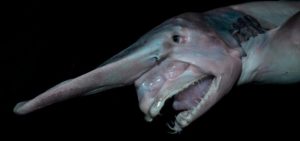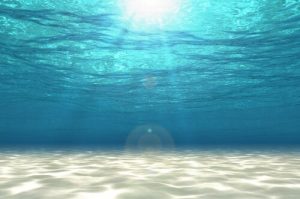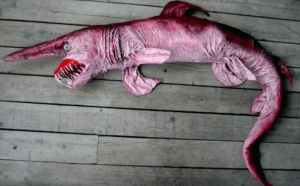Goblin Shark: Habitat and Facts

The goblin shark is a rather peculiar species because its large V-shaped snout makes it stand out and it reminds us of extinct animals. Do you want to learn about this magnificent creature? Below, are this animal’s main traits.
It’s a fish called elasmobranch lamniform and is the only living specimen of the Misukurinidae family. Its primitive features give it its second name, the living fossil.
Habitat
Actually, very little is known about the goblin shark because there are no certainties about the conditions of its habitat. However, we know that its natural habitat is located in the waters of Japan. You can also see them in Australia, India, France, South Africa, and the United States.
Even though this shark is a mesopelagic species that swims at a depth of 4,265 feet, normally they have been caught between 656 and 984 feet. This is an unpredictable behavior because the goblin shark usually doesn’t hang around in certain geographic regions.
That is why there are no complete studies that can provide more information on the goblin shark, their habitat and particularities.

Facts
Below are the goblin shark’s main traits:
- Among this animal’s distinctive traits, you can easily spot their peculiar snout that includes the upper part of the head, and its flattene shape that ends in a V shape.
- Their jaws arevery noticeable and they’re retractable, making its snout take on the shape of a large nose.
- Goblin sharks have 26 large, narrow, razon sharp teeth on the upper jaw, and 24 on the lowerjaw. They have three rows of teeth on each side of both jaws.
- Their fins are pinkish white and blue. This sharks have a flaccid appearance, even though they lack a lower lobe on their caudal fin.
- They have dorsal fins of equal shape and size. Their pectoral fins are short and rounded, with an anal fin larger than the dorsal fin.
- Regarding their body dimension, males are smaller than females. They measure between 9.8 and 13 feet in length. However, females can reach up to 20 feet in length.
- The average weight of an adult goblin shark is 463 pounds.
- They have very small eyes because they swim in very deep waters, and their skin is protected by structures called dermal denticles.
- When it comes to their reproduction process, they are likely to be ovoviviparous and they reach their sexual maturity once the males measure around 8.5 feet in length.
- Information on their life expectancy is unknown.
Feeding habits
The goblin shark uses special sensing organs called the Ampullae of Lorenzini that are located on their snout. With this, they are able to electronically detect the prey. Their jaws are conditioned for a rapid projection and thus this is how they capture their prey.
The strong ligaments of the mandibular joints keep them tight while swimming. When they find a prey, the jaw projects forward in the form of a catapult.
The shape of their thin and narrow teeth are shaped like a hole punch, and their posterior teeth are desgined for grinding. This suggests that they feed mainly on soft prey: small fish, octopus, squid, and shrimp.
Whereabouts of the goblin shark

It’s known that the goblin shark swims in deep water. They can live in the Atlantic Ocean, off the coasts of Guyana, Suriname, French Guyana, France, Madeira, Senegal, Portugal, the Gulf of Guinea and South Africa.
You can also find them in the western Pacific, off Japan, Australia, and New Zealand. Recently sightings have been reported on San Clemente Island off the coast of California, as well as north of the Gulf of Mexico.
Other important facts about the goblin shark
In regards to thier habitual behavior, the goblin shark is very difficult to capture, because they swim in very deep waters. Their most intense periods of activity are in the afternoon or very early in the morning.
Despite their strange appearance, the goblin shark isn’t an aggressive animal becuase they don’t represent any danger or threat to mankind. In fact, there are no records of goblin sharks attacks on people.
Finally, not to mention that there are still no protective measures taking place for this animal despite the fact that their very peculiar jaw arouses the interest of collectors and spectators.
This text is provided for informational purposes only and does not replace consultation with a professional. If in doubt, consult your specialist.